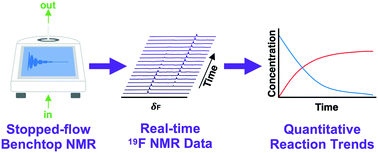Quantitative and convenient real-time reaction monitoring using stopped-flow benchtop NMR†
Abstract
Nuclear magnetic resonance (NMR) spectroscopy has the potential to serve as a widely applied reaction monitoring tool, particularly given the growth in commercially available benchtop NMR systems and accompanying flow cells. We herein present a stopped-flow benchtop NMR system devised of commercially available hardware components, all centrally controlled by an internally developed Python script. This system circumvents complications arising with continuous-flow NMR analyses and results in the ability to conveniently acquire quantitative reaction monitoring data. In our work, we first determine a set of 19F NMR acquisition parameters using benchtop NMR, allowing for quantitation using the absolute intensity method thereafter. This system and set of acquisition parameters are then applied to quantitatively monitor model reaction systems (via19F NMR, 57 MHz) that are difficult to otherwise monitor due to gas evolution, use/formation of toxic reagents, and formation of species otherwise difficult to detect. These reactions include the activation of a carboxylic acid using sulfuryl fluoride (SO2F2) and the formation of a carbamate via modified Curtius rearrangement with diphenylphosphoryl azide (DPPA).



 Please wait while we load your content...
Please wait while we load your content...